When it comes to versatile and breathable textiles, cotton gauze fabric stands out as a popular choice. But what is cotton gauze fabric, and why is it favored by so many? This comprehensive breakdown delves into the unique characteristics of cotton gauze, exploring its origins, properties, and wide range of applications.
Whether used in fashion, home décor, or crafting, cotton gauze offers a soft, airy feel that makes it ideal for various projects. Understanding what is cotton gauze fabric and how it can be utilized opens up endless creative possibilities.
What Is Cotton Gauze Fabric?
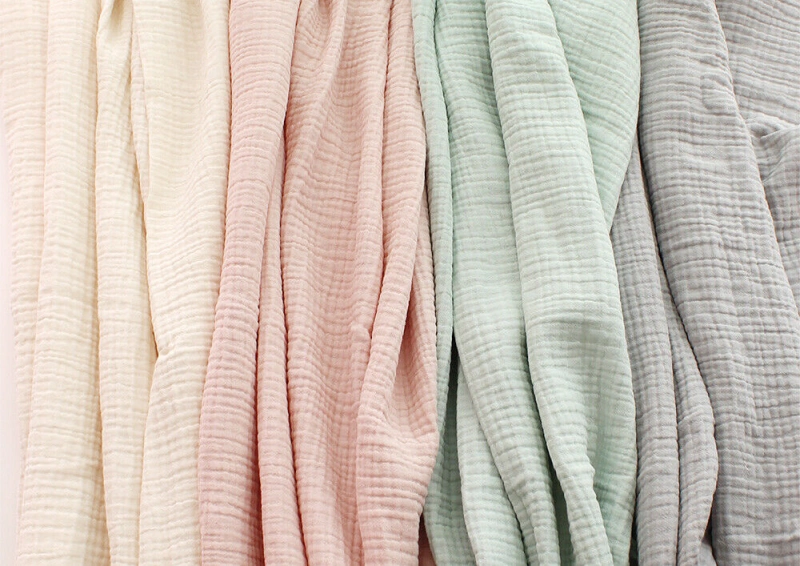
What Is Cotton Gauze Fabric? It’s a lightweight and breathable material known for its excellent moisture absorption. The open weave of cotton gauze fabric allows for outstanding air circulation, making it an ideal choice for various sewing projects. The production process involves carefully selecting yarn and maintaining strict control over the finishing stages.
This fabric is commonly used in medical settings for dressings due to its superior breathability and absorbency. Additionally, you’ll often find it in summer clothing, prized for its airy comfort. To keep cotton gauze fabric in top condition, proper care is essential.
What is Gauze Fabric?
Gauze is a thin, translucent fabric characterized by its loose, open weave, often resulting in a crinkled texture. This distinctive construction, often using a “leno weave” where weft yarns are crossed around warp yarns, provides stability despite the fine, loosely spaced threads. While it can be made from various fibers like silk, wool, or synthetics, cotton gauze is widely known for its softness, breathability, and excellent absorbency, making it popular for everything from medical dressings to lightweight clothing and home decor.
Cotton Gauze Fabric History
The origins of gauze fabric are ancient, with its loose, open weave serving various purposes across different civilizations. While the exact timeline is debated, the term “gauze” is widely believed to derive from Gaza, a Middle Eastern city renowned for its textile production.
- Early 2000s: Cotton gauze saw a resurgence in fashion, particularly for relaxed, comfortable summer wear, building on its historical uses beyond medicine.
- Ancient Times: Gauze-like materials were used by the Ancient Egyptians for mummification and wound care.
- 13th Century: Intricately woven silk gauze from Gaza was exported to Europe, indicating its value as a luxury textile.
- 17th-18th Centuries: Cotton gauze gained prominence in Europe and Asia, becoming common for both medical dressings and lightweight clothing due to its breathability and absorbency.
- 19th Century: Joseph Lister’s advancements in antiseptic surgery solidified gauze’s role as a sterile and essential medical dressing.
What Is Cotton Gauze Fabric Made Of?
Cotton gauze fabric is predominantly made from 100% cotton fibers, a natural cellulose material derived from the cotton plant. These fibers are processed through steps like harvesting, cleaning, carding (straightening), and spinning to create fine to moderate thickness yarns. The natural properties of cotton—its softness, breathability, and absorbency—are what make gauze so highly sought after for various applications.
The distinctive open and loose weave of gauze is achieved through either a plain weave or, more commonly, a “leno weave.” In a leno weave, the warp yarns (running lengthwise) are crossed around the weft yarns (running crosswise) in pairs, effectively locking them in place. This unique weaving technique prevents the fine, loosely spaced threads from easily unraveling or fraying, while also contributing to the fabric’s characteristic airy and slightly crinkled texture.
Cotton Gauze Fabric Manufacturing Process
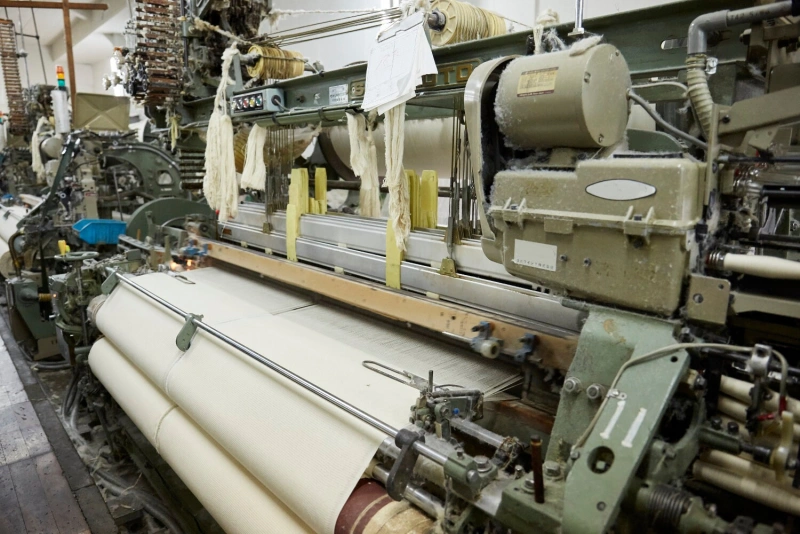
Understanding the cotton gauze fabric manufacturing process is crucial for anyone working with this material. It begins with yarn preparation, which is key to producing a fabric that is both strong and breathable. This process allows you to appreciate how the fabric’s distinctive mesh effect is achieved through loom weaving. Additionally, the bleaching and finishing stages play a vital role in enhancing the fabric’s color, texture, and overall quality.
Yarn Preparation
The first step in making cotton gauze fabric is preparing the yarn, a critical process that directly impacts the fabric’s final quality and durability. For gauze, selecting yarns with specific properties, such as breathability, absorbency, and strength, is key.
The yarns undergo a meticulous preparation process to ensure they are consistent and ready for weaving. This stage not only prepares the yarns for the loom but also strengthens them, laying the foundation for a durable fabric. The quality of cotton gauze fabric is heavily influenced by the quality of the yarn preparation. Without this careful groundwork, the final fabric could lack strength and durability.
Weaving Process
Once the yarn is ready, it is woven on a loom to create the distinctive open mesh structure of cotton gauze fabric. This particular weave pattern is what gives gauze its signature breathability and lightness.
Bleaching Process
Bleaching is a key step in the production of cotton gauze fabric, enhancing its appearance and texture by making it more uniform, clean, and bright. This process is crucial for ensuring the fabric meets the high standards required for various applications.
During bleaching, the fabric is treated to achieve consistent color and brightness, which not only improves its visual appeal but also its texture. Beyond aesthetics, bleaching plays a vital role in preparing gauze for diverse uses, such as in summer garments and baby products. Without bleaching, gauze fabric would fall short of quality standards, limiting its utility in fashion and other practical applications.
Finishing Touches
After weaving, the cotton gauze fabric undergoes a meticulous finishing process designed to enhance its texture and appearance. This involves precise mechanical and chemical treatments that give the fabric its characteristic softness, crinkled texture, and light, airy feel.
The finishing process is what transforms cotton gauze fabric into a high-quality, versatile material suitable for a wide range of uses.
What to Make With Gauze Fabric
The versatile nature of gauze fabric makes it an ideal choice for a wide range of creative projects, leveraging its soft drape, breathability, and relaxed aesthetic. From comfortable apparel to delicate home accents, its unique texture adds a touch of organic beauty to anything it’s transformed into.
Here are some popular items to make with gauze fabric:
- Baby Items: Burp cloths, receiving blankets, and breathable car seat covers.
- Apparel: Lightweight tops, flowing dresses, skirts, comfortable loungewear, baby clothes, and swaddling blankets.
- Accessories: Scarves, hair wraps, and lightweight shawls.
- Home Decor: Sheer curtains or drapes, table runners, decorative throws, and pillow covers.
- Crafts: Unique gift wrapping, delicate sachet bags, or elements in mixed-media art.
Cotton Gauze Fabric Features

Lightweight
Cotton Gauze fabric’s lightweight nature makes it ideal for warm-weather clothing, offering an airy feel that is perfect for summer. Its open, plain weave structure not only adds practicality but also style, featuring a unique ribbed surface that enhances the visual appeal of any garment.
The fabric’s light to medium weight and slight horizontal stretch give it a beautiful drape, making it a popular choice for creating chic, comfortable pieces that move gracefully.
Breathability
What truly sets cotton gauze fabric apart is its breathability, making it a top choice in warmer climates. The open weave structure allows air to circulate freely, reducing heat retention and keeping the skin cool and comfortable. This breathability, combined with the fabric’s lightweight nature, makes it ideal for loose, breezy summer clothing, whether it’s a casual beach cover-up or an elegant summer dress.
Moisture Absorption
In addition to its breathability, Cotton gauze fabric is highly absorbent, which is essential for enhancing comfort. The open weave helps draw moisture away from the skin, keeping you dry in hot weather, while also allowing for quick evaporation so your clothes don’t stay damp. This moisture-absorbing quality makes gauze fabric a popular choice for towels, bandages, and baby products.
Easy to Sew
Cotton Gauze fabric isn’t just great for summer wear and baby products due to its absorbency; it’s also remarkably easy to sew, making it a standout in the textile industry. Whether you’re a beginner or an experienced seamstress, gauze’s lightweight and airy nature make it a breeze to work with.
The open, plain weave allows for easy needle penetration, and its slight horizontal stretch and soft texture make the fabric forgiving, accommodating minor sewing errors with ease.
What Is Cotton Gauze Fabric Used For?
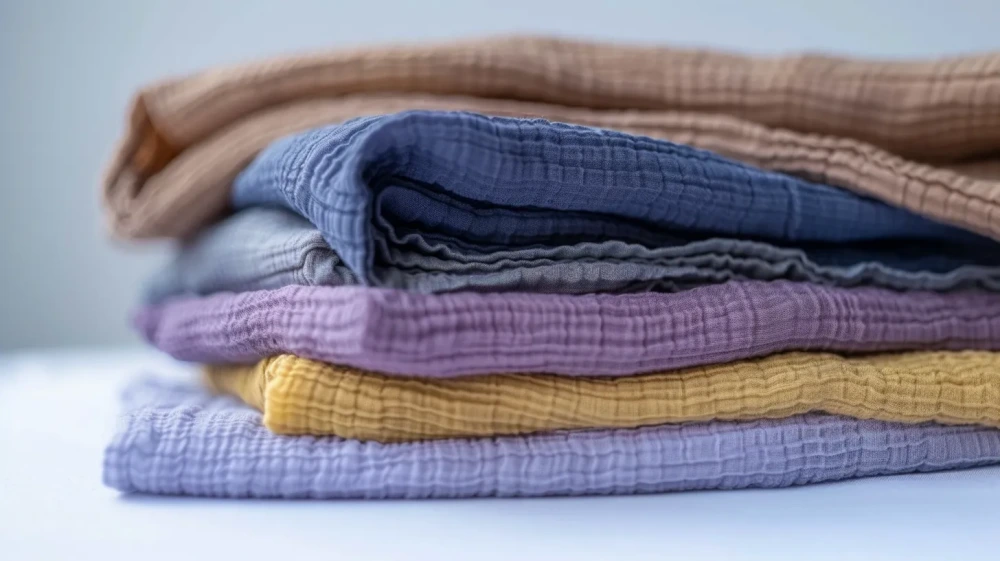
Gauze fabric, with its distinctive open weave and airy texture, boasts an impressive array of uses across various industries and everyday life. Its inherent qualities—lightweight breathability, softness, and excellent absorbency—make it a highly versatile material.
From its long-standing role in medical applications to its growing presence in fashion, home decor, and even culinary arts, gauze fabric consistently proves to be a practical and aesthetically pleasing choice, adapting seamlessly to diverse needs and preferences.
Medical Application: Cotton gauze fabric is widely used in the medical field for its absorbency, breathability, and gentle texture. It’s ideal for wound dressings, bandages, and surgical sponges, as it effectively absorbs fluids while allowing air to reach the skin, promoting faster healing. Additionally, its softness and hypoallergenic properties make it suitable for sensitive skin, ensuring patient comfort during treatment and recovery.
Fashion and Clothes: Cotton gauze fabric is favored for its lightweight, breathable, and versatile qualities. It’s commonly used in summer clothing like dresses, blouses, and scarves, offering comfort in warm weather. The fabric’s natural crinkled texture adds visual interest and a relaxed aesthetic, making it a popular choice for casual wear. Its ability to drape beautifully also makes it perfect for layering and creating flowy, elegant garments.
Home Decoration: Cotton gauze fabric is also popular in home decor, where it’s used to create airy, light-filtering curtains, soft bedspreads, and decorative throws. Its soft texture and natural appearance add a touch of rustic charm to interiors. Additionally, the fabric’s breathability makes it ideal for lightweight, breathable bedding and cushion covers, contributing to a cozy and comfortable living space.
What Stitch to Sew Cotton Gauze Fabric
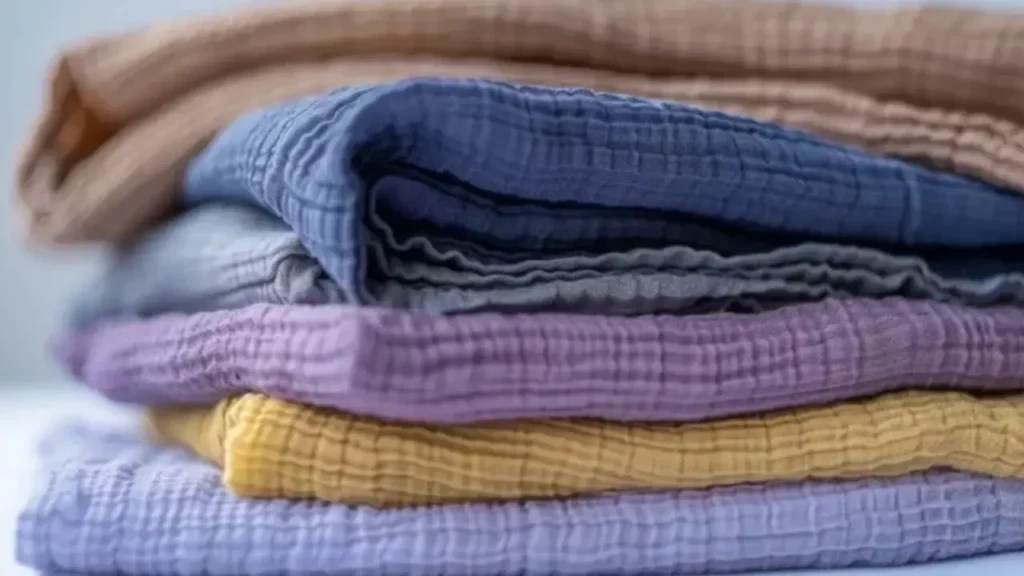
Sewing with cotton gauze fabric requires a gentle approach to maintain its delicate structure and prevent distortion. A longer stitch length is generally recommended to avoid puckering and allow the fabric to retain its natural drape and crinkle. French seams are an excellent choice for finishing seams on gauze, as they fully enclose raw edges, preventing fraying and providing a neat, durable finish that is well-suited to the fabric’s transparent nature.
Here are some specific stitch recommendations:
- Zigzag Stitch: Use a narrow, short zigzag stitch (e.g., 0.5 mm width, 2.0 mm length) to finish raw edges if a serger isn’t available, but avoid using it for main construction seams.
- Straight Stitch: Use a longer stitch length, typically 2.5 mm to 3.5 mm (or 10 to 8 stitches per inch), to prevent puckering.
- French Seams: Ideal for enclosing raw edges, creating a clean finish that’s perfect for gauze’s delicate weave.
- Overlock/Serger (if available): A 3- or 4-thread overlock stitch can provide a clean, durable seam finish, but test tension carefully to avoid stretching the fabric.
Cotton Gauze Fabric Buying Tips
When buying cotton gauze fabric, consider the specific application to ensure you select the right type. Cotton gauze comes in various weights and plies (layers), from single-ply ultra-sheer options ideal for swaddling or overlays, to multi-ply versions offering more opacity and structure, suitable for garments or drapery. Always check the fabric content to confirm it’s 100% cotton if you’re seeking its natural breathability and absorbency.
Here are some specific tips to guide your purchase:
- Read Reviews/Ask for Samples: If buying online, reviews can offer insights into drape, color accuracy, and shrinkage. Requesting a small swatch beforehand can be very helpful for evaluating the fabric firsthand.
- Check the Ply: Single-ply is very sheer; double-ply (or “double gauze”) is softer and more opaque; triple and quadruple plies offer even more substance and warmth.
- Examine the Weave: Look for a consistent, even weave. While gauze is inherently loose, irregular spacing or obvious snags might indicate lower quality.
- Feel the Hand: High-quality cotton gauze should feel soft and gentle against the skin, not stiff or scratchy.
- Consider Pre-Shrinking: Cotton is prone to shrinking. If you plan to wash the fabric, buy extra yardage and pre-wash it before cutting to avoid garment distortion.
How To Care for Cotton Gauze Fabric?
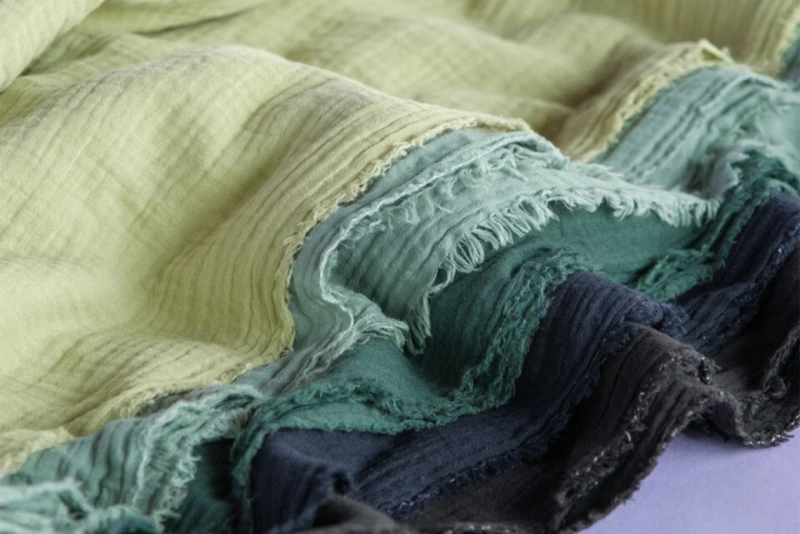
Lock In Color with Vinegar: To prevent color fading and preserve the original hue of your cotton gauze fabric, add a cup of white vinegar to the washing machine during the first wash. Vinegar acts as a natural color fixer, helping your garments retain their brilliance.
Gentle Drying For Optimal Shape: To maintain the fabric’s structure and prevent stretching, lay your gauze items flat to dry. This method is particularly effective in preserving the fabric’s delicate nature. For faster drying and added freshness, opt for drying in direct sunlight.
Embrace The Natural Wrinkles: Gauze fabric is renowned for its effortless, crinkled look. To maintain this characteristic, avoid ironing as it can damage the fabric’s delicate fibers and flatten its natural texture. Instead, let your gauze items air dry and enjoy their unique charm.
Conclusion
Cotton gauze fabric, with its rich history and unique characteristics, remains a beloved textile for its exceptional comfort, breathability, and versatile appeal. From its ancient origins to its modern-day applications in fashion, home decor, and medical fields, its soft, airy nature continues to make it a preferred choice for discerning consumers and creators alike.
Understanding its various plies, weaves, and care requirements ensures you can harness its full potential for any project. This ultimate guide aims to equip you with comprehensive knowledge about this remarkable natural fiber.
For all your creative and commercial needs, consider our wide selection of high-quality cotton gauze fabric. We offer competitive pricing and a diverse range to meet your wholesale demands, ensuring you have access to this timeless and adaptable material.
